Serial murderer Eddie Quist (Robert Picardo) is the epitome of the young punk our parents warned us to stay away from. He is also a werewolf. Note the poster design for The Howlingis essentially the other side of the poster for I Was a Teenage Werewolf!
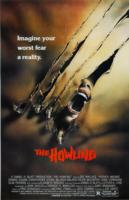
Werewolves[ Book Contents]
The Twilight Saga: New Moon [Chris Weitz, 2009]
The second film in the Twilightseries. In this picture all of the werewolves have nice bodies and rarely wear shirts in their human form.
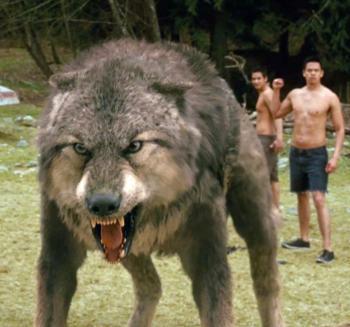
Werewolves[ Book Contents]
Wolf [Mike Nichols, 1994]
Jack Nicholson with Michelle Pfeiffer in a modern werewolf story. James Spader steals the picture as a rival werewolf.
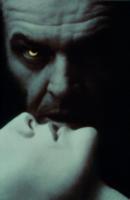
AN AMERICAN WEREWOLF IN LONDON
This was my attempt to make a movie dealing with the supernatural in a completely realistic way. Because there is no such thing as men who become monstrous wolves when there is a full moon, I tried to explore how one would react when confronted with this as truth. What do you do when the unreal is real? That was my premise and An American Werewolf in Londonis the result.
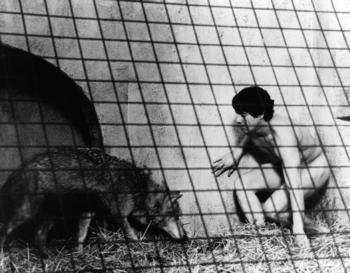
David Kessler (David Naughton) wakes up to find himself naked inside the wolf cage in The Regent’s Park Zoo.
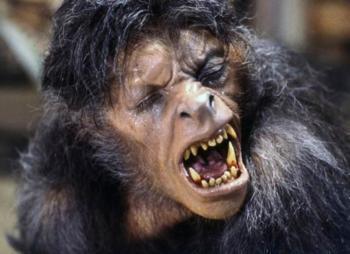
David Kessler (David Naughton) halfway through his painful metamorphosis.
Werewolves[ Book Contents]
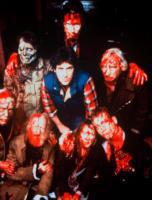
A publicity shot of David surrounded by the victims of his “carnivorous lunar activities” at a porno theater in Piccadilly Circus. His best friend Jack (Griffin Dunne), now also one of the “Living Dead,” is on his right. Jack is not a fresh kill and by now looks a little worse for wear.
“The wolf’s bloodline must be severed. The last remaining werewolf must be destroyed. It’s you, David!”
Jack (Griffin Dunne), An American Werewolf in London
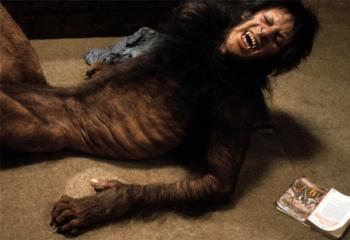
The transformation from a man into four-legged “hound from hell” is a painful one. Sinew, muscle, and bone stretch, bend, and crack. New, non-human flesh grows and limbs elongate, teeth become fangs, hair sprouts from all over the body, claws burst from fingers. The jaw unhinges from the skull and actually begins to grow into a snout. I recommend you do not try this at home.
IN CONVERSATION
Joe Dante
“It’s confronting death without having to really die.”
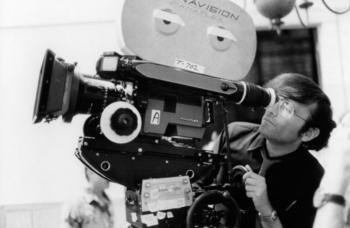
Director Joe Dante checks a shot on the set of Gremlins[1984].
Werewolves[ Book Contents]
JL: So, Joe, here on your office wall you have a poster from Creature From the Black Lagoon[Jack Arnold, 1954]…
JD: One of the great monsters of all time.
JL: Why?
JD: It’s one of the best-designed monsters. It’s a triumph, considering what was available at the time. There has to be something recognizably human about a great monster. And the greatest thing about the Creature is, of course, that he lusts after Julie Adams!
JL: But what’s he going to do when he gets Julie Adams? Isn’t he a fish?
JD: Well, I think he’s certainly part fish.
JL: Okay, we love the Creature. And you also have a large poster of La Belle et la Bête[Jean Cocteau, 1946] on the wall.
JD: Yes. That monster is also a great design, by Jean Cocteau. It’s kind of a Wolf Man design. The great thing about wolf men characters is that they are sort of dog-like, and so we tend to feel a kinship to them. The Jack Pierce make-up for The Wolf Man[George Waggner, 1941] is great, but there is something dog-pet-like about him.
JL: What about your werewolves in The Howling[1981]?
JD: The werewolves in The Howlingwere an attempt to get away from that dog-like look. We thought they should be more lupine, like they are in the old woodcuts.
JL: Do you really think the most effective monsters are humanoid?
JD: Well, what is a monster? A monster is something that isn’t normal, that doesn’t look like regular people. In the Middle Ages, anybody who had any kind of a deformity was considered to be a monster. There are a lot of superstitions about deformity. There are many fantasy creatures that are half man and half something else, like the Minotaur. But the fascination for monsters for my generation was basically that we were powerless kids and monsters were misshapen individuals who didn’t fit into society, who didn’t have any power, and who had to strike back. So, as a kid, you felt a kind of power watching a monster doing his stuff.
JL: Do you have a theory on why people like monster movies?
JD: It’s a difficult question. It’s confronting death without having to really die.
JL: What was the first monster movie that genuinely frightened you?
JD: I remember finding Christopher Lee’s Frankenstein Monster very scary [ The Curse of Frankenstein, Terence Fisher, 1957].
JL: How old were you? Five?
JD: I was eleven. I imagined that he was going to be coming upstairs from the cellar in our house! The whole thing about these movies is that you took them home with you. When I saw Them![Gordon Douglas, 1954], the giant ants made a sort of cricket-like, chirping kind of noise, very much like the sounds that would come from the field behind my house. Whenever a tree branch would rap on the window pane, I would think it was a giant ant antenna!
JL: But you really enjoyed seeing these movies, even though they would haunt you when you got home.
JD: I would come home and have nightmares, and my parents would say, “If you’re going to have nightmares, then why do you go to see these pictures?”
JL: And how would you answer them?
JD: “I have to.” I had to go see them. I couldn’t not go. I loved those movies. I loved all movies when I was a kid—particularly cartoons—but there was something about those pictures. They weren’t like other movies. They took place in worlds that I couldn’t even imagine, places that I couldn’t go to.
JL: The Exorcist, for me, is still probably the most successful horror movie.
JD: Yeah, it’s a brilliantly nasty movie. It’s very cleverly put together. At the beginning of the movie there are no make-up tricks or revolving heads or green vomit. By the time you get to that stuff, the audience has been pummelled into a state of being unable to resist watching whatever they’re going to do. They’ve got a girl peeing on the floor, they’ve got her masturbating with a crucifix… The movie breaks down your defenses until you’re just numb and ready to take all of the classic horror tropes which, had they been at the beginning, would not have worked.
JL: What was the first monster movie you saw?
JD: The Mad Monster[Sam Newfield, 1942]. It’s about a mad scientist (George Zucco) who turns this dim-witted handyman (Glenn Strange) into a werewolf. The reason this picture was so fascinating to me was that there was a little girl in it, whom the monster kills off-screen. We just see her ball bouncing back into frame.
JL: Were you scared by it?
JD: Sure I was scared: He killed a little girl! But it was a contained scared, because I saw it on TV. When I saw movies in the theater, that’s when I had nightmares. When you’re in a big theater and it’s dark, it’s truly scary! I was small and I didn’t want to have any heads to see over, so I would always sit in the front row, looking upwards, which I’m sure is why I have to wear glasses. I really liked movies that were about things that didn’t happen in real life—the fantastic. And in the early ’50s, when the space movies came out— This Island Earth[Joseph M. Newman, 1955] was a revelation—I was in heaven.